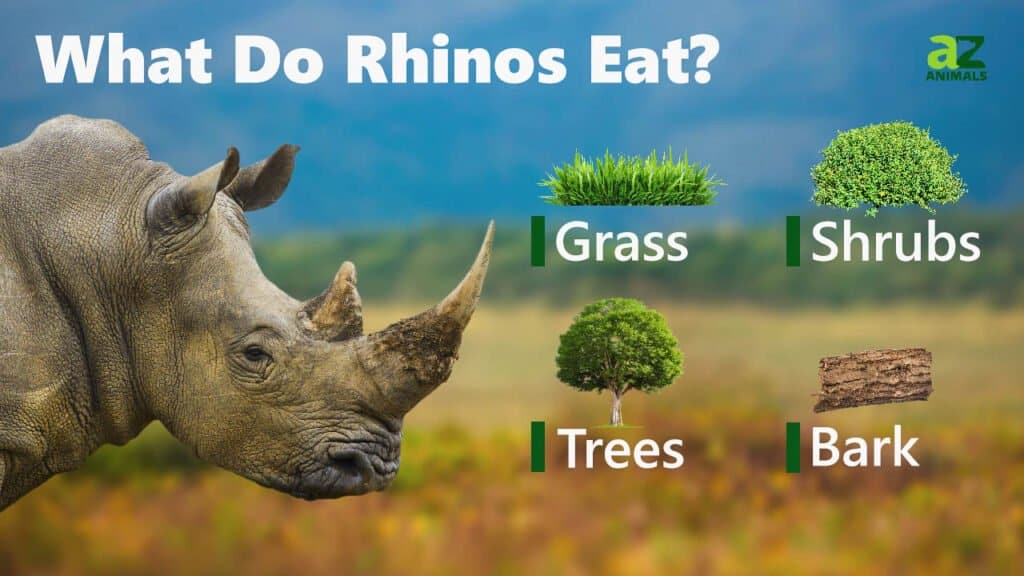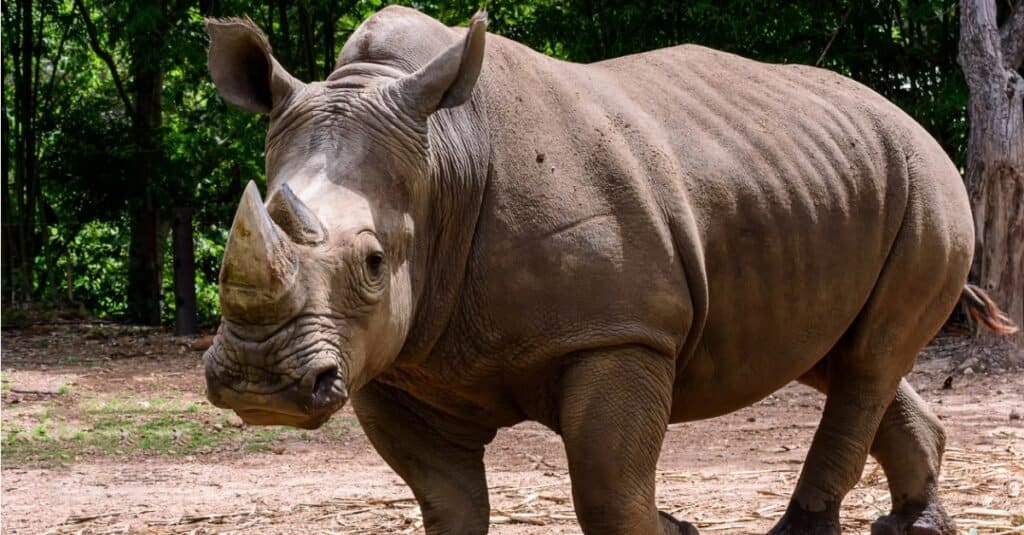
There are five species of rhinoceros alive today, each of which has its own unique physiological and environmental differences — while there may be some variance in their diets, there are some key characteristics that all species share. Rhinos are generalist herbivores, which means that their diet consists of a variety of different plant matter. The black rhino, for instance, has been witnessed consuming 32 of the 34 available plants in its environment. Diversity is important to the diet of the rhino, but this enormous herbivore also needs to consume a large amount of food just to stay nourished. While actual intake can vary depending on the species, some rhinos need to consume over a hundred pounds of grass a day to maintain their weight and nutrition.
In terms of dietary habits, rhino species fall into one of two categories. Grazers keep their heads down and primarily feed on grasses with a preference for shorter grasses. Indian and white rhinos are both classified as grazers. Black, Sumatran, and Javan rhinos all fall into the category of browsers. Rather than feed on grasses, they instead focus their attention on food that’s above eye level — with preferences including twigs, fruit, and leaves. Despite the variety of their diets, rhinos do have taste preferences — and a sweet tooth in particular — a fact that’s evidenced by the fact that they’ve been known to destroy farmland in pursuit of fruits. Browsers will graze and vice versa when necessary, and most species will resort to eating roots and bark when opportunities are scarce. Roots also offer hydration during dry seasons and droughts.
What Do Rhinos Eat in Captivity vs. the Wild?
Rhinos in captivity are typically fed on a diet of alfalfa and soy out of practical and financial necessity. Unfortunately, research into the feeding habits of the endangered Southern White Rhinoceros indicates that a diet like this could be responsible for infertility in females of the species. In the wild, these species may graze on dozens of different types of plants in a typical year, and chemicals called phytoestrogens are a regular part of their naturally occurring vegetarian diet. Without phytoestrogens, female rhinos often have trouble producing enough hormones of their own to support healthy reproductive cycles.
White Rhino vs. Black Rhino
White and black rhinos constitute the two species indigenous to Africa — and while they look quite similar, there are two major distinctions between them. The first is size. White rhinos are significantly larger, with an adult white rhino weighing an average of up to 5,000 pounds and the average black rhino weighing just half that. That’s reflected in their diets as well. A white rhino will often consume a hundred pounds of grass or more in a day, while black rhinos will consume just half that. The other big difference comes down to feeding habits. Black rhinos are browsers while white rhinos are grazers.
Rhinos eat a diet that includes:
- Grasses (roughly 40% of a grazer’s diet)
- Twigs
- Leaves
- Roots
- Bark
- Fruits
- Vegetables
- Alfalfa and soy (in captivity
How Do Rhinos Forage For Food?

©iStock.com/nuwatphoto
Food availability can determine whether rhinos are grazers or browsers, but different rhino species have also evolved different mouths to facilitate their foraging behaviors. Browsing rhinos have an upper lip that is pointed and prehensile to varying degrees. This allows them to operate their lips in a similar way to pruning sheers — clipping twigs, leaves, and fruit from trees and stripping bark from the surface. By contrast, grazers have a wider, square-shaped upper lip that allows them to consume large quantities of grass in a short time. Considering that the largest grazing species ― the African white rhino — can require over a hundred pounds of food in a day, it’s an essential trait.
The sheer amount of food that rhinos need to consume means that eating consumes a huge part of their day. Half of the time a white rhino is awake will be spent grazing and digesting. And while all of these species can be identified as generality herbivores, they tend to be particular in their consumption. Studies of the black rhino suggest that they eat almost all of the edible plants in their environment — but they’re selective with the plants they consume and will often prioritize foods that are either less readily available or don’t show immediate nutritional value. It suggests that despite them not being picky eaters, rhinos require diversity in their diets. Species like the Javan and Indian rhino will often prioritize aquatic plants thanks to both their nutritional content and their ability to hydrate.
As we learn more about the complexity of rhino feeding habits, it becomes more apparent that human encroachment is affecting their long-term nutrition. Their high nutritional demands necessitate large areas for grazing or browsing, and agricultural incursion often leads to conflict between rhinos and human communities. Human activity also seems to be having an impact on the feeding habits of rhinos as well. While all species are primarily diurnal, both black and white rhinos in particularly dangerous habitats have been seen resorting to nighttime feeding practices.
What Animals Eat Rhinoceros?
The plains of southern and eastern Africa are home to dangerous animals ranging from the lion to the Nile crocodile, but none of these apex predators are eager to go face-to-face with a grown rhinoceros. A healthy adult rhino only faces one true predator — humans. But while there have been anecdotes about African tribes feasting on rhinoceros meat after a big hunt, there’s no evidence to suggest this is anything more than clumsy attempts at publicity by big-game hunters. Most poachers will tear out a rhino’s horn to be resold on the black market and leave the carcass to rot in the sun.
Poaching is the greatest threat to rhinos as their horns are worth a great deal on the black market. Rhino horn is thought to enhance sexual vigor in traditional Chinese medicine. Given that rhino horn is made of the same material as all other horns, hooves and fingernails, this is ridiculous. However, there are still enough people who believe this that several species of rhinos are nearly extinct due to overhunting.
While adult rhinos are not likely to fall to a natural predator, the calves are another case entirely. Both African and Asian rhino calves are sometimes prey for large cats — lions and tigers respectively. In most instances, predators won’t actively hunt calves but won’t pass up on the opportunity to pick off a calf that strays from the herd. Calves are especially easy prey at night, where the poor eyesight of rhino mothers makes it easy for them to lose track of their offspring. Other predators that prey on rhino calves are pack-hunting hyenas and Nile crocodiles.
Up Next…
- Are Rhinos Extinct: The Conservation Status of Every Rhino Species Rhinos face severe threats to their continued existence. Check on their status in this article.
- What are Rhino Horns Made of & the Largest Rhino Horn Ever! Rhinos are hunted for their horns. Find out what their horns are made of in this article.
- How Many Rhinos Are Left In The World? Just how many rhinos are left? Find out here.
The photo featured at the top of this post is © iStock.com/Udo Kieslich
Thank you for reading! Have some feedback for us? Contact the AZ Animals editorial team.






